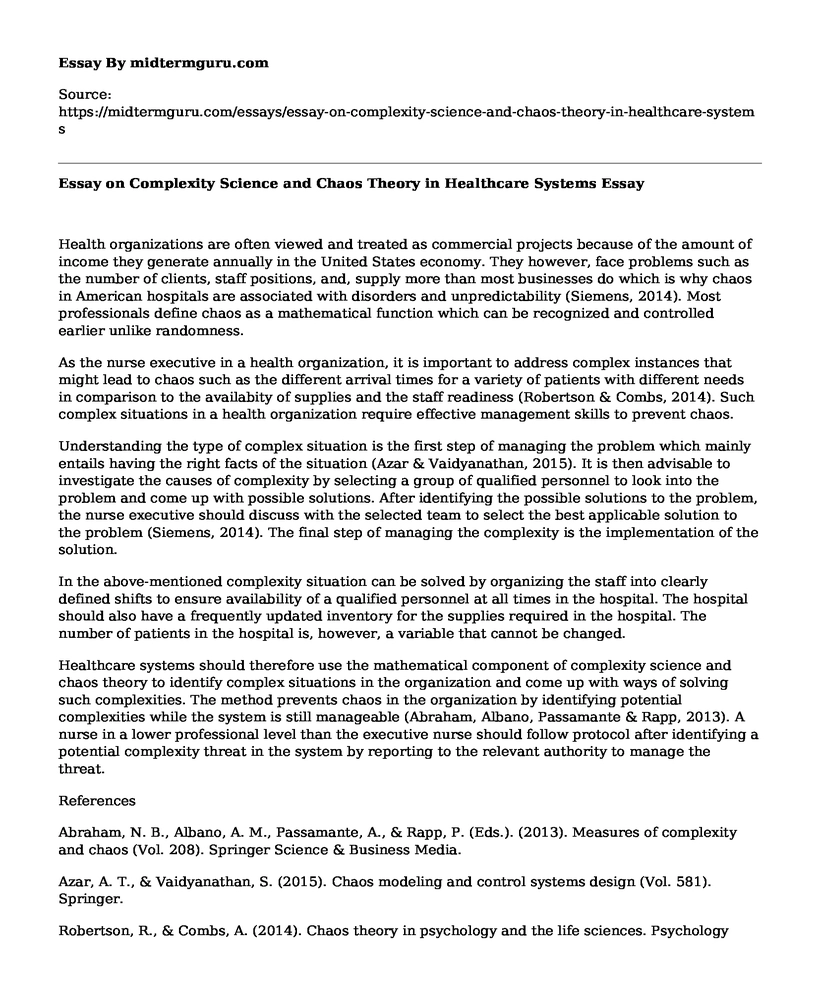Health organizations are often viewed and treated as commercial projects because of the amount of income they generate annually in the United States economy. They however, face problems such as the number of clients, staff positions, and, supply more than most businesses do which is why chaos in American hospitals are associated with disorders and unpredictability (Siemens, 2014). Most professionals define chaos as a mathematical function which can be recognized and controlled earlier unlike randomness.
As the nurse executive in a health organization, it is important to address complex instances that might lead to chaos such as the different arrival times for a variety of patients with different needs in comparison to the availabity of supplies and the staff readiness (Robertson & Combs, 2014). Such complex situations in a health organization require effective management skills to prevent chaos.
Understanding the type of complex situation is the first step of managing the problem which mainly entails having the right facts of the situation (Azar & Vaidyanathan, 2015). It is then advisable to investigate the causes of complexity by selecting a group of qualified personnel to look into the problem and come up with possible solutions. After identifying the possible solutions to the problem, the nurse executive should discuss with the selected team to select the best applicable solution to the problem (Siemens, 2014). The final step of managing the complexity is the implementation of the solution.
In the above-mentioned complexity situation can be solved by organizing the staff into clearly defined shifts to ensure availability of a qualified personnel at all times in the hospital. The hospital should also have a frequently updated inventory for the supplies required in the hospital. The number of patients in the hospital is, however, a variable that cannot be changed.
Healthcare systems should therefore use the mathematical component of complexity science and chaos theory to identify complex situations in the organization and come up with ways of solving such complexities. The method prevents chaos in the organization by identifying potential complexities while the system is still manageable (Abraham, Albano, Passamante & Rapp, 2013). A nurse in a lower professional level than the executive nurse should follow protocol after identifying a potential complexity threat in the system by reporting to the relevant authority to manage the threat.
References
Abraham, N. B., Albano, A. M., Passamante, A., & Rapp, P. (Eds.). (2013). Measures of complexity and chaos (Vol. 208). Springer Science & Business Media.
Azar, A. T., & Vaidyanathan, S. (2015). Chaos modeling and control systems design (Vol. 581). Springer.
Robertson, R., & Combs, A. (2014). Chaos theory in psychology and the life sciences. Psychology Press.
Siemens, G. (2014). Connectivism: A learning theory for the digital age.
Cite this page
Essay on Complexity Science and Chaos Theory in Healthcare Systems. (2021, Jun 07). Retrieved from https://midtermguru.com/essays/essay-on-complexity-science-and-chaos-theory-in-healthcare-systems
If you are the original author of this essay and no longer wish to have it published on the midtermguru.com website, please click below to request its removal:
- Essay on Elements of Safety in the Aviation Industry
- Essay Sample on Parental Support for Children
- Essay Sample on Public Health
- Paper Example on Peplau's Theory of Interpersonal Relations
- How Low-Dose Ionizing Radiation Causes Childhood Cancer? - Research Paper
- Research Paper on Risk Management
- What Is Going On With DHS in Strategic Sourcing? - Essay Sample







